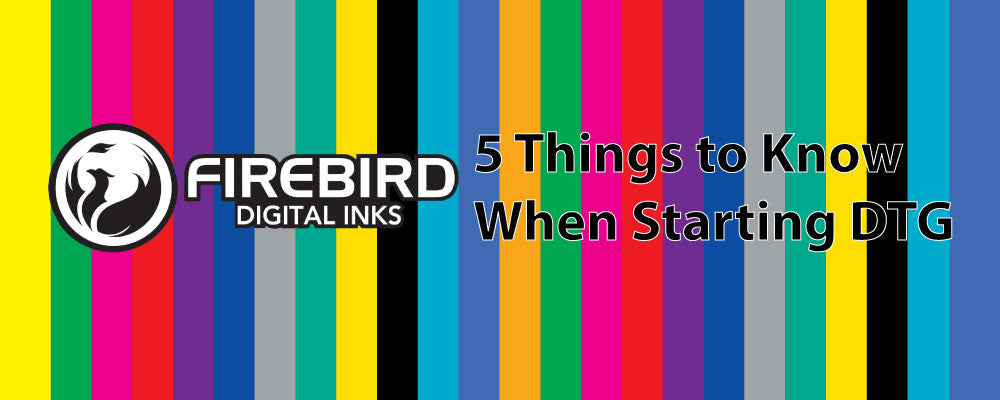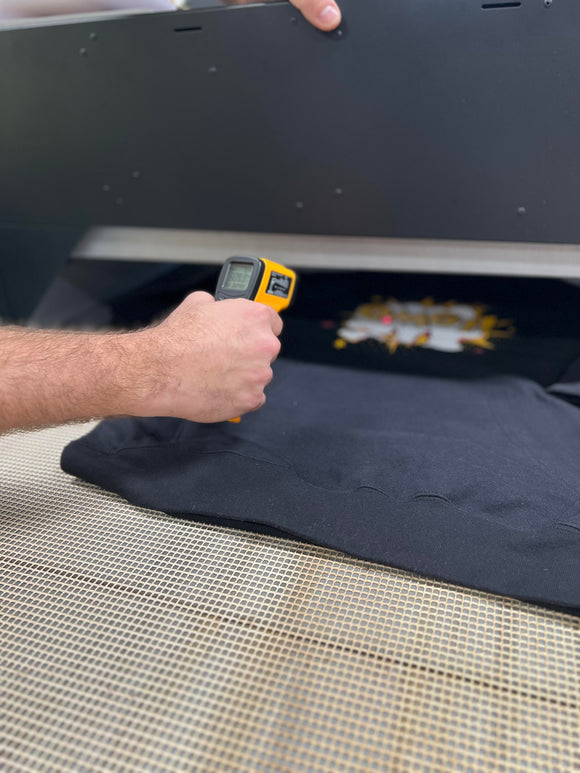
5 Things to Know When Starting DTG
Ruby Dann
1) Don’t Go All in at Once
One of the best parts of Direct to Garment printing is that you can run it in a small space. Setups in home garages and spare bedrooms are common and allow for orders to be fulfilled without the need to pay rent. A printer, heat press, and a hand sprayer for pretreat are all that you immediately need. These don’t take much space and, with luck, you can find them for $10,000 or less. Additionally, DTG can be completely successful as an ecommerce Small quantities of custom orders are where DTG printing shines and many owners of these machines won’t bother with having a physical store to sell their own designs.

Of course, this assumes that your business will even have room for DTG. While veterans of garment decoration need a reliable source for small orders, owners of clothing brands are better off avoiding the cost of equipment for as long as they can. There are many companies that will ship your shirts directly to your customer, with no need for you to do more than make an account and find sales. If you are the owner of a clothing brand, the best advice for you is to focus on selling and designing. You can worry about buying equipment later.
2) White Ink Settles Anywhere That it Sits
Ink settling is the cause of most maintenance problems in Direct to Garment printing. However, most DTG initiates don’t understand all of the problems that this can cause. Printer manufacturers always tell their customers to shake their white ink. Unfortunately, what new owners don’t always understand is that white ink will settle in your lines, dampers, and filters if you don’t use or clean your printer often. When you let it sit overnight, you will see a poor quality white on your first couple prints in the morning. If your printer isn’t used for a few days, you may see clogs and the need to replace parts. Additionally, bags and cartridges need to be shaken constantly or your print quality will suffer.
3) Used Printers Almost Always Have Problems
Buying a used printer is one of the most common reasons you'll see DTG owners asking for tech support. The sellers of these machines typically let the printers sit unused and un-maintained. If ink was in the printer, you can expect any and all of the previously mentioned settlement problems. You will still see broken parts if Cleaning Solution, water, or no fluid was left in the lines as a result of previously lubricated parts becoming dry.
Overall, you should avoid used printers unless you know what you’re getting into. If you can see the printer in action or receive a written guarantee, the printer may be worth your time. Additionally, some veteran users will come to your shop to repair broken down printers for less than the cost of buying new. Other companies also sell refurbished printers, which is comparable to the quality you can expect from new machines. The important thing is to find what will fit your budget, but still let you begin printing and making your money back right away.
4) Pretreatment Settings Aren’t Standard
Not all shirts are created equal. You will need to adjust settings when changing between shirt brands and colors if you want consistent prints. This is true even for pretreatment. If you lay down a single amount of pretreat for all colors and all brands, you will lose image quality and wash fastness. FIREBIRD typically suggests using more pretreatment on lower quality and darker shirts. Less is needed for higher quality and lighter colors.
The easiest way to adjust the amount of pretreatment used is with an automatic sprayer. However, even these expensive machines lack standard settings. You may be surprised to know that your own machine has no check for how much pretreat is put on the shirt. While auto sprayers have numbers indicating the amount of pretreatment applied, they are only showing “more” or “less”. Additionally, many sprayers have not been calibrated, so two of the same brand may spray different amounts with the same settings. The only way to really understand your settings is to do your own tests. This brings us to our final, most important point.
5) The Most Successful Printers do Their Own Tests
No two shirt shops are identical. Your exact combination of shirts, printers, and even climate affect everything you print. Because of this, experimenting is key. We suggest performing wash tests on any garment that you bring into your setup. You should also keep notes on the ink and pretreatment settings that you used on your best prints.

FIREBIRD has specific issues to look out for included in our other posts. Below is simply a bit of general DTG advice to help you get started with your testing.
- If your shirt washes poorly, pay attention to how the image came off. Different problems cause different wash issues.
- Polyester needs special handling to work with DTG. This includes blends, sweatshirts, and any “neon” or “safety” colored shirts.
- Red shirts discolor from heat. This will fade as the shirt cools and there is no reason to worry.
- Too much pretreatment is likely to stain and wash poorly. Too little pretreatment will suffer from poor print quality and wash out. Try to find the “sweet spot” for colors and brands.
Of course, you shouldn’t be afraid to reach out to FIREBIRD. We have a broad knowledge base and are available by email at ink@firebirdink.com.


